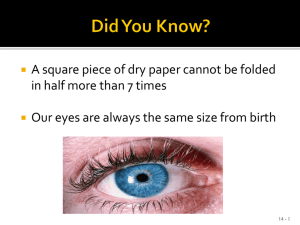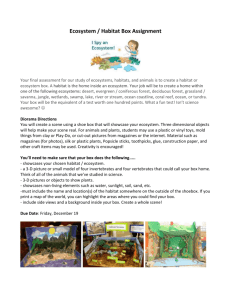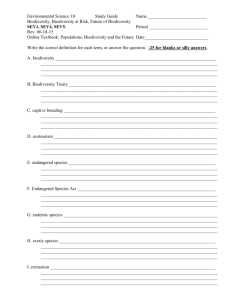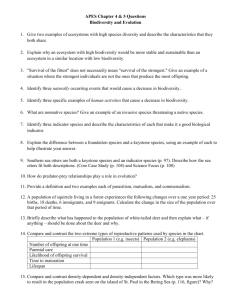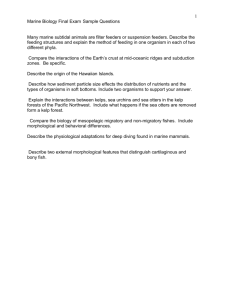File
advertisement
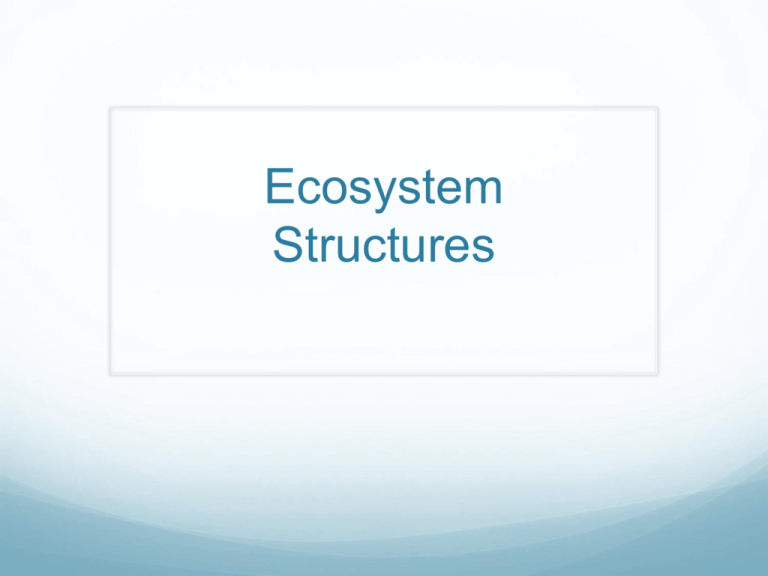
Ecosystem Structures Ecosystem Structure Different Species Playing Different Roles • Biological communities differ in the types and numbers of species they contain and the ecological roles those species play. • Species diversity: the number of different species it contains (species richness) combined with the abundance of individuals within each of those species (species evenness). • Types of species– – – – – Indicator Keystone Foundation Umbrella Native vs. Non-indigenous/Invasive Indicator Species Indicator Species Biological Smoke Alarm Have a very small limit of tolerance Serve as early warnings of damage to a community or an ecosystem. Trout species- indicator of water quality sensitive to temperature and oxygen levels of water Lichen – indicator of air quality Sensitive to toxic gases like sulfer and ozone Frogs- indicator of water pollution Case Study: Why are Amphibians Vanishing? Frogs serve as indicator species because different parts of their life cycles can be easily disturbed. Amphibians breathe partially through their skin, which is constantly exposed to the environment so their bodies are much more vulnerable and sensitive to factors such as disease, pollution, toxic chemicals, radiation, and habitat destruction Figure 7-3 Case Study: Why are Amphibians Vanishing? Habitat loss and fragmentation. Prolonged drought. Pollution. Increases in ultraviolet radiation. Parasites. Viral and Fungal diseases. Overhunting. Natural immigration or deliberate introduction of nonnative predators and competitors. Why are Amphibians Vanishing? • Farm fertilizers often contain large amounts of phosphorous and nitrogen. • Boosts algae production which in turn boost the population of certain flatworm parasites. • These parasite attack frogs at their larval stage tadpoles causing them to develop deformities in adulthood. • Deformities include missing or extra limbs. Keystone Species Keystone Species a species whose role is essential for the survival of many other species in an ecosystem help determine the types and numbers of other species in a community thereby helping to sustain it. Keystone Species – Sea Stars • Keeps mussels from dominating the shore line thus helping less competitive species to persist – Sea Otters• Eat sea urchin that destroy kelp beds – Grizzly Bear• Transfers nutrients from oceanic ecosystems to forest ecosystems by catching salmon rich in nitrogen, carbon, phosphorous and sulfur. Sea Otters and West Coast of North America. European and Russian trappers hunt sea otters to near extinction in the 18th and 19th centuries. • The decline of the sea otters, which are essential to keeping sea urchins in check, allows sea urchin populations to explode. • The burgeoning sea urchins feast on and decimate the kelp beds, which are critical habitat for spawning fish. • Fish begin to decline for lack of spawning habitat; this affects fishermen's catches. • In areas where the otters recovered, urchin populations are once again kept down, the kelp beds recover, fish nurseries recover, and fish catches rise again. Foundation Species– Dominant primary producer in an ecosystem in both abundance and influence • Kelp/Kelp Forest • Coral/ Coral Reef • Trees within a forest Removal disrupts fundamental ecosystem processes, including rates of decomposition, nutrient fluxes, carbon sequestration, and energy flow Umbrella Species Umbrella Species species that, through its protection, protects other species that live within its habitat. Native and Invasive Species Native species those that normally live and thrive in a particular community. Invasive species those that migrate, deliberately or accidentally introduced into a community. Introduced Species: Rabbits in Australia Introduced into Australia from England in 1859 No natural enemies – rabbit population exploded Overabundant herbivore population devastated natural vegetation. Used disease-causing viruses to control rabbit pop. Using disease as control measure – why will this procedure fail in the long-term? Would this particular virus be considered a parasite or a predator? Rabbits Overgrazing in Australia Phillip Island 1978 Largely devoid of vegetation Phillip Island 1988 After Rabbit Removal Interactions Among Species • Species can interact through competition, predation, or symbiosis (mutualism, commensalism, parasitism) • Some species evolve adaptations that allow them to reduce or avoid competition for resources with other species (resource partitioning). • Competition for– – – – Food Space Water Mates (among species) Interactions Among Species Resource Partitioning • Each species minimizes competition with the others for food by spending at least half its feeding time in a distinct portion of the spruce tree and by consuming somewhat different insect species. Figure 7- Interactions Among Species Predation Predator (organisms that captures & feeds on parts or all of another animal) vs. Prey (organisms that is captured & serves as a source of food for another animal). Interactions Among Species Predator/Prey populations are often cyclical Interactions Among Species Mutualism: Win-Win Relationship Two species can interact in ways that benefit both of them. Figure 7-9 Interactions Among Species Commensalism: • Using without Harming • Some species interact in a way that helps one species but has little or no effect on the other. Figure 7-10 Interactions Among Species Parasites: • Sponging Off of Others • Parasites harm their hosts – Some parasites live in host (micororganisms, tapeworms). – Some parasites live outside host (fleas, ticks, mistletoe plants, sea lampreys). – Some have little contact with host (dump-nesting birds like cowbirds, some duck species) Population Dynamics Carrying CapacityThe maximum population of a particular species that a given habitat can support over time. The barrel represents the habitat, the water pouring out represents population loss due to various elements and the water in represents new species within the population being born into that particular habitat Population Dynamics • A population can grow until competition for limited resources increases & the carrying capacity (C.C.) is reached. • Populations grow rapidly with ample resources, but as resources become limited, its growth rate slows and levels off. • As a population levels off, it often fluctuates slightly above and below the carrying capacity. • Members of populations which exceed their resources will die unless they adapt or move to an area with more resources. Figure 8- Population Dynamics A: Represents the biotic potential of the species B: Shows how the population overshoots the carrying capacity C: Represents the logistic growth D: Represents linear growth E: Carrying capacity- the maximum number of individuals that can be supported by a particular ecosystem. Reproductive Patterns The populations of different species vary in how long individual members typically live. Survivorship Curve- • The way to represent the age structure of a population is with a survivorship curve. – Late loss population live to an old age. – Constant loss population die at all ages. – Most members of early loss population, die at young ages. Reproductive Patterns Reproductive Patterns r-selected species tend to be opportunists K-selected species tend to be competitors. Reproductive Patterns Reproductive Patterns: Opportunists and Competitors • Large number of smaller offspring with little parental care (r-selected species). • Fewer, larger offspring with higher invested parental care (K-selected species).
